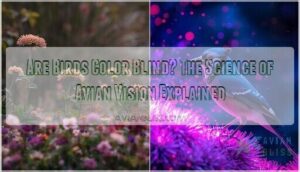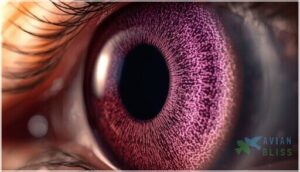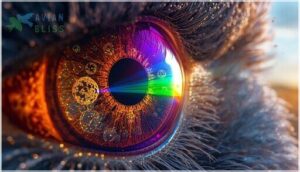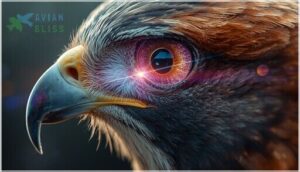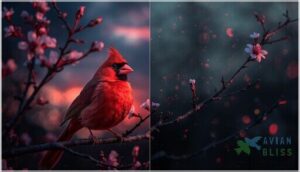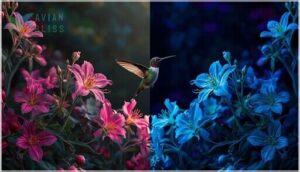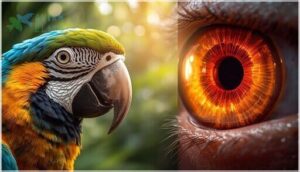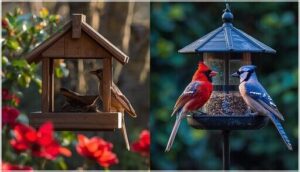This site is supported by our readers. We may earn a commission, at no cost to you, if you purchase through links.
If you’ve ever wondered whether the robin on your lawn sees the world in shades of gray, you’re asking the wrong question. Birds aren’t color blind—they’re color superheroes. While you’re limited to the roughly 10 million color shades your three types of cone cells can detect, birds operate with four, unlocking an expanded spectrum that includes ultraviolet wavelengths completely invisible to you.
That blue jay at your feeder doesn’t just see blue; it perceives UV patterns on feathers that signal health, dominance, and genetic quality during mate selection. This tetrachromatic vision isn’t just a biological curiosity—it’s a survival toolkit that shapes every aspect of avian life, from spotting the ripest berries to identifying their own eggs among a brood parasite’s forgeries.
Table Of Contents
- Key Takeaways
- Are Birds Color Blind?
- How Birds’ Eyes Detect Color
- What Colors Can Birds See?
- Which Colors Are Hard for Birds to See?
- Do All Birds See Colors Equally?
- The Role of Ultraviolet Light in Bird Vision
- How Color Vision Affects Bird Behavior
- How Bird Vision Compares to Human Vision
- Are Any Birds Truly Color Blind?
- How Bird Color Vision Influences Birdwatching
- Frequently Asked Questions (FAQs)
- Conclusion
Key Takeaways
- Birds possess tetrachromatic vision with four types of cone cells that allow them to see ultraviolet wavelengths completely invisible to humans, giving them access to a vastly expanded color spectrum used for mate selection, foraging, and survival.
- While birds excel at UV and most color detection, they face limitations with certain red hues due to genetic constraints and environmental factors like dim lighting, creating species-specific gaps that affect foraging and mating behaviors.
- Color vision varies significantly across bird species based on habitat and diet—forest birds developed shorter-wavelength UV receptors for dense vegetation, while open-habitat species favor longer UV wavelengths for better contrast, and fruit-eaters show sharper discrimination than predatory birds.
- Ultraviolet light plays a practical role beyond mate selection, enabling birds to identify ripe berries through UV-reflecting properties, detect cryptic insects faster, and navigate during migration, while also helping some species distinguish their own eggs from brood parasites.
Are Birds Color Blind?
Why do people still believe birds are color blind? It’s one of those myths that refuses to die, even though science has thoroughly debunked it. You won’t find any evidence supporting bird color blindness, because birds aren’t just capable of seeing colors—they’re better at it than you are.
Birds aren’t color blind—they see more colors than you do, including ultraviolet wavelengths invisible to human eyes
Most bird species possess tetrachromatic vision, meaning they use four types of cone cells for color detection, while humans make do with three. This gives them access to a broader spectrum, including UV perception that’s completely invisible to us. Behavioral studies consistently show birds discriminating colors with striking accuracy, often exceeding 70% even when hues are closely related. Species variations do exist—some ground-dwelling birds have adapted differently—but color vision remains fundamental across avian life.
Birds use their UV light perception to find food. From mate selection to foraging, birds rely on their heightened color perception for survival. The real question isn’t whether birds see color, but rather how their exceptional avian vision shapes every aspect of their world.
How Birds’ Eyes Detect Color
Birds aren’t just seeing the world differently—they’re seeing more of it. Their eyes are built with specialized structures that capture and process color in ways our own vision can’t match.
Let’s break down the key features that give birds their striking color detection abilities.
Structure of Avian Eyes
The foundation of bird vision starts with eye anatomy that’s both familiar and remarkably specialized. Your feathered visitors process the world through structures adapted over millions of years:
- Transparent cornea and dual-layered sclerotic ring provide structural support and protection
- Flexible lens with accommodation mechanisms allows rapid focus adjustments via ciliary muscles
- Layered retina packed with photoreceptor cells captures and processes incoming light
- Pecten function supplies oxygen without obstructing vision through blood vessels
These retinal layers contain remarkable photoreceptor density, setting the stage for superb color detection. Birds also possess excellent visual acuity, vital for safe flight.
Four Types of Cone Cells
You’ll find four single cone types in most birds’ retinas, each tuned to different wavelengths: violet (around 370 nm), blue (450 nm), green (480 nm), and red (570 nm). This tetrachromatic vision system far exceeds your three-cone setup.
Each cone contains oil droplets with carotenoid pigments that filter light, sharpening color discrimination. Birds also have double cones for detecting motion and brightness, not color itself.
Light Sensitivity and Field of View
Beyond those specialized cones lies considerable light sensitivity. Diurnal birds pack roughly 80% of their photoreceptors as cones, maximizing color discrimination in bright conditions.
You’ll notice their laterally placed eyes create visual fields exceeding 300 degrees, though binocular overlap varies from 10° to 50° depending on species.
UV transmittance through the cornea and lens extends ultraviolet vision, with spectral tuning enhanced by oil droplets that sharpen photoreceptor distribution for precise vision coordination.
What Colors Can Birds See?
Birds don’t just see the world in color—they see colors you can’t even imagine. Their visual spectrum stretches far beyond what your eyes can detect, opening up a hidden dimension of hues and patterns.
Let’s break down exactly what birds perceive and how their color vision compares to yours.
Visible Spectrum in Birds
Your avian vision extends far beyond human capability, spanning approximately 320 nm to 680 nm of the visible light spectrum. This striking color perception hinges on four cone pigments with spectral sensitivity peaks tuned to different wavelengths—including one absorbing near 570 nm for red-green discrimination.
Oil droplets in cone cells sharpen color discrimination by filtering overlapping wavelengths, enhancing your feathered subjects’ nuanced color vision across the entire color spectrum.
Ultraviolet Perception
Your ability to see ultraviolet light—wavelengths around 360–373 nm—opens a hidden dimension in bird vision that remains invisible to you without special equipment.
This UV vision range allows feathered species to detect plumage UV reflectance during mate selection, recognize egg UV coloration in nesting sites, and improve foraging by spotting UV-reflective fruits and nectar sources, showing considerable species UV variability across avian groups.
Comparison to Human Color Vision
Compared to your trichromatic vision, birds operate with four cone types that expand spectral sensitivity into ultraviolet territory. This tetrachromatic system creates distinct differences in color perception and visual acuity:
- Birds detect UV wavelengths (300–400 nm) you can’t see, adding a fourth dimension to their color vision.
- Enhanced color constancy allows avian visual systems to maintain consistent hues despite lighting changes.
- Enhanced motion detection stems from higher cone and rod density in their retinas.
These advantages transform how birds experience their world.
Which Colors Are Hard for Birds to See?
You might assume that birds, with their four-cone visual system, see every color under the sun with perfect clarity. However, even these feathered marvels have their blind spots regarding color perception.
Let’s explore which hues fall outside their impressive visual range and why these limitations matter for their daily survival.
Limitations With Red Hues
You might think birds see red as brilliantly as we do, but genetic constraints and red cone sensitivity actually limit their red hue perception. Carotenoid influence in retinal cells restricts the range of red tones birds can distinguish, unlike their ultraviolet mastery.
Environmental impacts like dim lighting further reduce red detection, affecting how birds navigate food sources and mating displays—challenging the notion that birds have unlimited color vision.
Species-Specific Color Gaps
You’ll find that bird color perception isn’t uniform—species variations in bird vision create distinct gaps in the perception spectrum. Wavelength discrimination depends heavily on hue, with chromatic reliance outweighing brightness or saturation.
When colors share close wavelengths, discrimination drops sharply due to irregular hue distribution. This variation in color vision in birds means some species navigate colorblindness-like gaps that affect how they interpret their world.
Impact on Foraging and Mating
Color perception gaps directly shape your ability to observe foraging behavior and mating behaviors in action. When birds struggle with certain red hues, it cascades through critical survival functions:
- Foraging Efficiency: Birds rely on color cues to assess food profitability, though they favor natural greens over bright reds at feeders
- Food Identification: Tetrachromatic bird vision detects subtle fruit ripeness differences you can’t perceive
- Mate Attraction: UV reflectance in Plumage Color drives female choice more than visible spectrum alone
- Behavioral Implications: Males display vibrant colors strategically in dense vegetation for maximum conspicuousness
- Species variation: Raptors depend less on color for hunting than songbirds do for foraging
Understanding avian color perception reveals why certain colors succeed in attracting mates while others fail in food-related contexts.
Do All Birds See Colors Equally?
Not all birds see the world through the same lens. While most species share the basic four-cone visual system, the number and distribution of those cone cells can vary greatly between different types of birds.
Let’s look at how color vision differs across species and what factors shape these variations.
Differences Among Bird Species
Regarding avian vision, not all bird species are created equal. The peak sensitivity of the fourth cone differs—some birds detect ultraviolet wavelengths, while others perceive violet, reshaping their entire color world.
Habitat color impact drives these adaptations; forest dwellers excel at detecting greens and yellows, whereas open-country species tune into lighter grays. Dietary pigment effects also play a role, as carotenoid intake modifies oil droplet pigmentation in cone cells, fine-tuning spectral sensitivity.
Brain processing differences add another layer—Bengalese finches rely on brightness over hue, unlike their zebra finch relatives. These UV vision variances and cone cell variations mean color discrimination thresholds vary widely, influencing everything from mate choice to foraging success across parrots, songbirds, chickens, and raptors.
| Visual Feature | UV-Sensitive Species | Violet-Sensitive Species |
|---|---|---|
| Fourth Cone Peak | 355-380 nm | 402-426 nm |
| Blue Cone Shift | Shorter wavelengths | Longer wavelengths |
| Habitat Examples | Open environments | Forest canopies |
| Color Strengths | UV patterns, mate signals | Green/yellow detection |
| Diet Influence | High carotenoid needs | Variable pigment allocation |
Parrots, Songbirds, and Chickens
When you compare parrots, songbirds, and chickens, you’re seeing variations on a common theme in avian visual physiology. Parrots leverage parrot UV vision for social signaling through plumage patterns, while songbird color cues guide mate selection and territorial displays. Chickens, surprisingly, demonstrate striking chicken color constancy across lighting conditions, thanks to their five cone types.
- Parrots use four cone cells including UV-sensitive receptors for enhanced mate recognition
- Songbirds categorize colors similarly to you in red-orange ranges but perceive finer UV distinctions
- Chickens maintain five photoreceptor types with highly regular cone cell mosaics optimizing color sampling
These cone cell mosaics follow similar density patterns across species, yet each group adapts color vision to its ecological niche—parrots for complex social environments, songbirds for breeding displays, chickens for reliable foraging under variable light.
Influence of Habitat and Diet
Beyond species differences, your local birds fine-tune their color vision based on where they live and what they eat. Forest species develop shorter-wavelength UV photoreceptors for detail in dense vegetation, while open-habitat birds favor longer UV wavelengths for improved contrast. Diet matters too—fruit-eaters and nectar-feeders show sharper color discrimination, while predatory birds sacrifice color range for higher visual acuity.
| Habitat Type | UV Vision Adaptation | Dominant Plumage Coloration |
|---|---|---|
| Open habitats | Longer-wavelength UV tuning | White, light gray for signaling |
| Forested environments | Shorter-wavelength UV receptors | Green, yellow, blue matching foliage |
| Lower forest strata | Enhanced close-range detail | Rufous, brown camouflage tones |
This habitat color evolution and diet color perception create visual acuity tradeoffs—hummingbirds rapidly learn color-nectar associations for efficient foraging, while scavengers prioritize distance vision over chromatic richness.
The Role of Ultraviolet Light in Bird Vision
You mightn’t see ultraviolet light, but birds live in a world illuminated by it.
This invisible spectrum plays a surprisingly practical role in their daily survival, from choosing the right partner to spotting the ripest berries.
Understanding how birds use UV light reveals just how different their visual experience is from ours.
UV Light and Mate Selection
When you’re watching birds court, you’re missing a secret language that unfolds in ultraviolet wavelengths. UV light transforms mate selection through mechanisms invisible to human eyes:
- UV Signal Amplification increases chromatic contrast up to 25 times in species like budgerigars, making displays unmistakable
- Sensory Bias Exploitation draws on evolved preferences that amplify attraction responses
- Feather Microstructure broadcasts quality indicators through UV reflectance patterns
- Reproductive Hormone Regulation reacts to UV perception, hastening sexual maturity by 1-3 days
- Ecological Light Modulation shapes how effectively UV signals work across different environments
Female starlings rank males differently depending on UV wavelengths present, while female zebra finches avoid males lacking UV-reflective plumage entirely.
This sexual selection pressure operates continuously, with approximately 72% of surveyed bird species using UV-reflective colors in courtship displays.
UV Patterns in Plumage and Eggs
UV reflectance is woven into the plumage of over 312 bird species across 142 families, with more than 80% of birds-of-paradise converting UV light into vivid yellows and greens.
Eggshell UV chroma helps some species distinguish their own eggs from those of brood parasites.
These UV ecological role markers vary by habitat, with forest specialists showing stronger UV signals adapted to filtered light conditions.
UV Use in Foraging and Navigation
When you’re watching redwings forage, you’ll notice they prefer UV-reflecting bilberries over duller options, showing how UV foraging cues drive food selection. Blue tits find cryptic insects faster with UV vision, while migratory birds rely on UV light as navigation mechanisms under dim skies.
These spectral adaptation abilities provide evolutionary advantages, improving foraging efficiency and directional accuracy.
UV exposure also offers environmental enrichment, reducing stress and enhancing natural behaviors in captive settings.
How Color Vision Affects Bird Behavior
Color vision isn’t just a neat trick for birds—it’s woven into nearly every aspect of their daily lives. From choosing a mate to spotting a juicy caterpillar, what birds see shapes how they behave and survive.
Let’s look at three key areas where their visual abilities make all the difference.
Mate Attraction and Plumage Display
You might wonder why male cardinals flash bright red feathers while females wear muted browns. This sexual dimorphism in birds has an important purpose in mate selection.
Males use plumage coloration as visual cues during courtship displays, signaling health and genetic fitness to potential mates. These mating displays showcase ultraviolet patterns invisible to you, yet critical for avian attraction and successful mating behaviors.
Territorial and Social Interactions
Territorial displays rely heavily on plumage coloration and visual signaling to establish boundaries and social hierarchies. Birds use habitat-specific colors—white in open areas, red in forests—to enhance visibility during these confrontations.
Interspecific aggression often occurs between species competing for breeding resources, with UV patterns facilitating social recognition within flocks. This avian communication system maintains order, reduces conflict, and shapes mating behaviors across species.
Food Identification and Predator Avoidance
Your bird vision doesn’t just help you admire bright plumage—it’s critical for survival. Color palatability cues let you spot ripe berries and learn to avoid toxic prey through aposematic color signals, while UV food detection reveals otherwise hidden food sources.
Learned color associations develop quickly, often within 20 visits, shaping foraging strategies and predator avoidance behaviors that directly impact your feeding success and safety in the wild.
How Bird Vision Compares to Human Vision
When you compare bird vision to human vision, the differences go far beyond what meets the eye. Birds don’t just see the world differently—they see more of it, thanks to an extra type of cone cell that unlocks colors we can’t even imagine.
Understanding these distinctions reveals why birds behave the way they do and how their visual world shapes every choice they make.
Cone Cell Differences
Your eyes and a bird’s eyes work fundamentally differently in terms of color vision. While you rely on three types of cone cells to detect red, green, and blue wavelengths, birds possess four single cone types plus double cone origins, creating tetrachromatic vision. This structural difference means:
- Cone spectral sensitivities extend into ultraviolet ranges you can’t perceive
- Oil droplet function filters light, enhancing color discrimination between photoreceptor cells
- Spatial cone distribution and opsin gene expression create richer color experiences
Color Range and Sensitivity
Beyond the structural cone cell advantage, your visual world stops at roughly 700 nm wavelength, while avian vision extends into ultraviolet territory around 310-360 nm. This tetrachromatic vision gives birds access to color combinations you can’t imagine—like UV-green or UV-red blends.
Spectral filtering through oil droplets sharpens their color discrimination further, while ocular transmittance in UV-sensitive species allows 50% light passage near 323 nm. Their color perception range fundamentally reshapes how they experience flowers, plumage, and landscapes.
| Vision Feature | Human Range | Bird Range |
|---|---|---|
| Wavelength Detection | 380-700 nm | 310-700+ nm |
| Cone Cell Types | 3 (Trichromatic) | 4 (Tetrachromatic) |
| UV Sensitivity | None | Peak 360-373 nm |
| Ocular UV Transmittance | Blocked | 50% at ~323 nm |
| Color Discrimination | Limited Spectrum | Enhanced with Oil Droplets |
Behavioral Implications of Vision Differences
When birds detect ultraviolet mate selection signals invisible to you, they’re operating in a fundamentally different behavioral reality. Your vision shapes how you interpret a landscape, but their tetrachromatic color perception drives critical survival decisions.
Foraging color reliance permits identification of UV-marked fruits, while predator detection speed increases through broader visual fields.
Social visual cues and territorial display vision depend entirely on perceiving color dimensions you’ll never access, fundamentally altering avian behavior.
Are Any Birds Truly Color Blind?
You might’ve heard old myths suggesting that birds are color blind, but science tells a completely different story. Research over the past few decades has consistently shown that birds can see color, but most species actually perceive a richer palette than we do.
Let’s look at what the scientific evidence reveals, how evolution shaped avian vision, and why those outdated myths continue to circulate.
Scientific Studies and Findings
When you examine the research, you’ll find that no bird species has ever tested positive for color blindness. Behavioral data from jackdaws shows over 70% accuracy in color discrimination tasks, while physiological evidence confirms tetrachromatic vision across species.
Wild bird studies using spectrophotometers reveal that birds actively use UV reflectance and color cues for survival, proving their vision systems are fully functional, not deficient.
Evolutionary Adaptations in Vision
Over millions of years, avian evolution has refined vision through genetic mutations driven by environmental pressures and behavioral ecology. You can see how positive selection shaped eye-development genes, enhancing visual acuity for hunting, foraging, and mate choice.
Vision adaptations reflect sensory tradeoffs: nocturnal species lost photoreceptor genes to boost low-light performance, while diurnal birds gained UV sensitivity.
The evolution of vision in birds mirrors their ecological demands perfectly.
Myths About Bird Color Blindness
Misinformation about bird color vision persists, but you’ll find no scientific support for claims that birds are color blind or can’t see blue. Debunking bird color blindness reveals tetrachromacy across most species, though vision uniformity doesn’t exist—nocturnal birds show limited color vision adaptations.
Colorblindness prevalence in birds resembling human-scale vision deficiencies isn’t supported by evidence. UV importance in color perception demonstrates birds actually surpass human capabilities, with blue perception particularly well-developed for survival behaviors.
How Bird Color Vision Influences Birdwatching
Understanding how birds perceive color can transform the way you approach birdwatching and backyard bird attraction. Your choice of feeder colors, house designs, and garden features directly influences which species visit and how they interact with your space.
Let’s explore three practical ways you can apply avian color vision science to improve your birdwatching experience.
Choosing Feeder and House Colors
When setting up bird feeders and bird houses, you’ll want to look beyond human aesthetics and focus on what actually attracts birds. Silver and green feeders receive the most visits across species, while red and yellow—despite their popular appeal—rank lowest in bird color preferences.
For birdhouses, natural tones like brown and gray provide essential camouflage, though species preferences vary. Always choose non-toxic, non-reflective paint for safety.
Observing Behavioral Responses
You can learn volumes about avian behavior simply by watching how birds respond to color in your yard. Their color preferences reveal the complex way color vision shapes daily survival decisions:
- Foraging behavior varies dramatically—house sparrows actively avoid yellow feeders while blue tits show strong silver preferences
- Social interactions shift when birds encounter colored leg bands, with orange and red reducing aggression between individuals
- Predator detection improves as birds use color discrimination to spot camouflaged threats and recognize warning patterns on toxic prey
These responses demonstrate how mate selection, territorial displays, and food identification all depend on birds’ excellent color perception.
Enhancing Backyard Bird Attraction
You can transform your yard into a bird magnet by applying what you’ve learned about avian color vision. Feeder color selection matters—green and silver bird feeders blend naturally while attracting diverse species, and red draws hummingbirds when paired with safe nectar colors free from artificial dyes.
Plant color schemes featuring yellow sunflowers and orange lilies create bird-friendly gardens using species-specific preferences and natural camouflage colors for birdwatching success.
Frequently Asked Questions (FAQs)
Do birds see more colors than humans?
You might think your world bursts with color, but birds perceive an even richer palette. Their tetrachromatic vision grants access to ultraviolet light and spectral dimensions beyond human reach, expanding their avian color range dramatically.
Do birds have good color vision?
Yes, birds have remarkable color vision. Their tetrachromatic system with four cone cells fosters heightened color discrimination ability and spectral sensitivity range compared to humans, supporting precise color perception vital for survival and reproductive success.
Are birds colorblind?
Contrary to common color vision myths, birds aren’t colorblind—they possess tetrachromatic vision with enhanced color constancy and avian discrimination abilities.
Their spectral sensitivity surpasses humans, making limited color vision in birds or dichromatic perception scientifically unfounded.
How do birds see color?
Birds detect color through four distinct types of cone cells in their retinas, each containing specialized visual pigments called opsins. These opsins respond to different wavelengths of light, enabling tetrachromatic vision with enhanced spectral sensitivity.
Can birds see Blue?
Picture a bluebird’s feathers catching sunlight—you’re seeing just part of what the bird perceives.
Thanks to tetrachromatic vision and UV-blue interaction, birds detect blue wavelengths far beyond your visual range, enhancing mate selection and ecological navigation.
Can birds see colors that are invisible to US?
Absolutely. Your feathered visitors perceive ultraviolet light—wavelengths between 300 and 400 nanometers that remain completely invisible to you.
This UV vision reveals plumage patterns, food sources, and mating signals hidden from human eyes, expanding their color perception beyond our trichromatic limitations.
What colors do birds see?
Your eyes capture red, green, and blue, but birds perceive ultraviolet light too. Tetrachromacy in avian vision grants them access to UV coloration, enhancing color perception far beyond the visible light humans detect.
Which birds are Colour blind?
While most daytime species boast superior color perception, nocturnal bird vision differs greatly. Owls and nightjars likely experience color blindness due to rod-dominated retinas and low-light adaptations, sacrificing cone cells for enhanced night sensitivity.
What colors do birds avoid?
Birds avoid bright neon colors like red, yellow, and orange, which signal danger. Shiny reflective surfaces cause discomfort, while black resembles predators.
Blue light triggers caution in some species, and white creates alarming contrast.
What color attracts birds?
Blue, green, and silver consistently draw many species to feeders, while orange and yellow appeal to orioles and goldfinches.
Hummingbirds favor red and pink, reflecting species color preferences and ecological color roles in avian vision.
Conclusion
Picture a world where every petal glows with hidden signals, where the dullest sparrow outshines your visual range by an entire dimension. That’s the reality birds inhabit daily. The question “are birds color blind” misses the mark entirely—they’re operating with sensory hardware you can’t replicate.
Their tetrachromatic advantage isn’t just evolutionary showmanship; it’s a reminder that perception itself is species-specific, and what you see barely scratches the surface of what exists.

